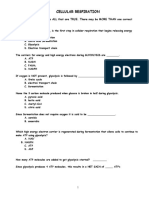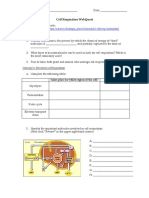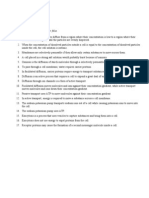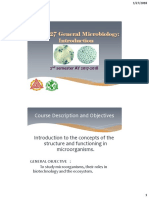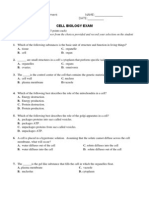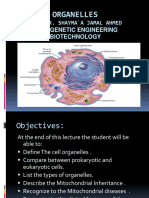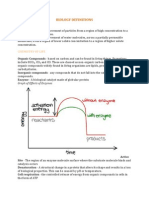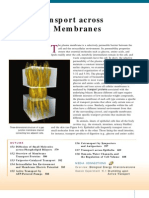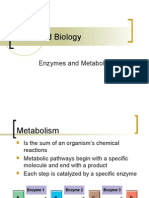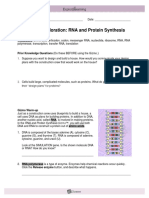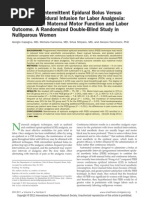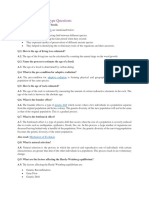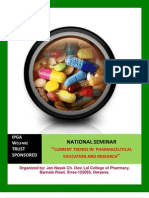Enzymes Worksheet
Enzymes Worksheet
Uploaded by
Claudia PinnaCopyright:
Available Formats
Enzymes Worksheet
Enzymes Worksheet
Uploaded by
Claudia PinnaOriginal Description:
Original Title
Copyright
Available Formats
Share this document
Did you find this document useful?
Is this content inappropriate?
Copyright:
Available Formats
Enzymes Worksheet
Enzymes Worksheet
Uploaded by
Claudia PinnaCopyright:
Available Formats
Name: _________________________
2.2.3 Enzymes Worksheet
Enzymes
Most reactions take place in a number of __________ which need to be _________________________ if the cell is to function properly ______________ are the most important controllers of cellular reactions
Catalysts
_______________ speed up reactions without themselves being involved in the reaction. ______________ are catalysts made of ____________ they speed up a reaction without being used up themselves in the reaction. Because enzymes are made in living things they are called ____________________ (or organic catalysts) We learned in the section on food that proteins are made when ____________________ join together. The function of a protein is decided not only by the _______________ of amino acids but also by the way the protein __________. Most enzymes are ________________ proteins
How enzymes work
Enzymes are not flat they have a 3D structure
Each enzyme has its own __________________________ that will only fit the molecule that the enzyme is designed to work on. If the enzyme that breaks down starch into glucose meets a fat molecule it _______________________ and will not be able to work on it. Page 1 of 8
Name: _________________________
Enzyme Action
The substance that an enzyme acts on is its __________________ The substance(s) that the enzyme forms is called the ________________
A Catabolic enzyme
Amylase converts ____________ to ______________. Catabolic as it breaks a __________ molecule into a __________ one. It is produced by ___________________ in mouth and by the ______________.
An Anabolic Enzyme
______________________________ forms and repairs DNA. Anabolic as it coverts __________ molecules into more __________ molecules. Found in almost all living things
Page 2 of 8
Name: _________________________
Consider This
Amylase is an enzyme found in saliva. It breaks starch molecules into smaller maltose molecules. What is the substrate? What is the product? Will amylase break fats into fatty acids + glycerol? Why? Is this an example of a catabolic or an anabolic reaction? Why?
And This
DNA Polymerase is an enzyme that builds DNA using tiny molecules in our cells. What is the substrate? What is the product? Will amylase build keratin out of peptides? Why? Is this an example of a catabolic or an anabolic reaction? Why?
Enzymes work because they have the correct shape to fit the substrate. They have a ______________________________________________ shape to fit the substrate. When enzymes and their substrates meet and come together they form an _________________________________ complex.
Enzyme Reactions are ___________________. Like a key can open or close a lock enzymes can ________________________ ________________________________.
Page 3 of 8
Name: _________________________ In the following example the enzyme can break molecule X into Y+Z but it can also combine Y+Z to form X
Naming Enzymes
Enzymes are named by adding the suffix ______ to the name of their _________________. Eg. Enzyme that acts on Amylose (starch) is called ______________. Enzymes that act on proteins are called __________________.
Inhibitors
Inhibitors attach to enzymes and _______________________________. When this happens the enzymes are said to be __________________.
Nerve Gases
The nerve gases we hear of terrorists using are often ________________ that attach to enzymes involved in our ___________________________.
Poisoning people the old fashioned way!
______________ denatures an enzyme involved in _____________________.
Page 4 of 8
Name: _________________________
Beneficial Inhibitors
________________________ affect ______________ in insects causing their death. __________ can affect ______________ involved in pain causing the pain to stop. ____________________ can affect ______________ in bacteria causing the bacteria to die.
Enzymes at work!
Enzymes work best in certain conditions Factors that affect enzymes include: ______________ ______________ ______________ concentration ______________ concentration We will be examining these in experiments
Temperature
At very low temperatures ice forms, liquids become solids and enzymes cant work. As temperature increases molecules start to ___________ and bump into each other causing the rate of reaction to _______________.
Human enzymes work best at ___________________ (____C) Plant Enzymes work best at ____-____ C Above certain temperatures enzymes start to lose their __________ the rate of reaction __________. When the shape is fully lost the enzyme is said to be __________________ this is usually a ___________________ condition.
Page 5 of 8
Name: _________________________
pH
pH scale goes from 0 -14 0-7 is ___________ 7-14 is __________ (or ________________)
Enzymes work over a ________________ pH range Most enzymes work at pH ____ - ____ Outside this they lose shape and get __________________ The ________________ or best pH is usually pH 7
An Exception!
Is our stomach acid or basic? __________________ Do you think there are enzymes in our stomach? ________________ ____________ is an enzyme in the stomach that works best at pH 2!
Immobilised Enzymes
__________________________ is the use of enzyme controlled reactions to produce a product. Bioprocessing can be used to produce a vast range of products such as ______________, beer, _____________________, vaccines, methane gas, food flavours, vitamins and perfumes.
Page 6 of 8
Name: _________________________
Traditionally microorganisms such as _____________ and __________ were used but since the 1900s and especially since the 1950s ______________ are being used.
If enzymes are used freely _________________ in a vessel it can be very wasteful as they are ________ at the end of the process To prevent this problem enzymes are often _____________________ or fixed. This means they are ________________ to ______________ or an _________ _______________ and can be used repeatedly.
How to immobilise enzymes
Physical methods __________________ where enzymes are physically attached to inactive supports such as glass beads or ceramics. _______________________________________________ when enzymes are kept within a membrane. ____________________, sodium alginate is commonly used this allows substrates in and products out. Chemical Methods _______________________ enzymes chemically bonded to a support such as glass beads or ceramics. ________________________________. Enzymes are chemically bonded to each other.
Advantages of Immobilised Enzymes
_________________ of enzyme is not affected Immobilised enzymes can be __________________________ from the product so you can get a pure sample of product easily. Immobilised enzymes ______________________ this cuts costs. Enzymes ________________ become _________________________ when immobilised.
Page 7 of 8
Name: _________________________
Uses of Immobilised Enzymes
Immobilised glucose isomerase converts ______________ to ______________ which is used to sweeten drinks.
Penicillin acylase changes the _______________ of penicillin to make more _________________ that will fight a wider range of bacteria
Lactase converts _____________ to sweeter sugars ______________ and ___________________ which are then used by food manufacturers
Syllabus Can you.......
Define the term: enzymes State the nature, folded shape & functions of enzymes. Explain the role of enzymes in plants and animals including role in metabolism Explain the effects of pH & temperature on enzyme activity. State the procedure and advantages of Bio-processing. State the use of Bio-processing. END
Page 8 of 8
You might also like
- Vernier Caliper Worksheet With Example Solution PDFDocument3 pagesVernier Caliper Worksheet With Example Solution PDFClaudia Pinna100% (5)
- Level 3 Diploma in Health and Social CareDocument4 pagesLevel 3 Diploma in Health and Social CareGibson0% (1)
- Enzymes Review Worksheet: Name: . DateDocument4 pagesEnzymes Review Worksheet: Name: . Dateapi-233187566100% (1)
- Biology Staar Review Stations Day 3Document12 pagesBiology Staar Review Stations Day 3api-267841335No ratings yet
- 13.3 Power Notes BiologyDocument2 pages13.3 Power Notes BiologyX GodinezNo ratings yet
- CELLULAR RESPIRATION Review WorksheetDocument8 pagesCELLULAR RESPIRATION Review WorksheetMhai MontanoNo ratings yet
- 13 Cellular Respiration-KEYDocument8 pages13 Cellular Respiration-KEYfkjnf100% (1)
- Visible Biology Site License Lab Activities Prokaryotic and Eukaryotic Cells StudentDocument13 pagesVisible Biology Site License Lab Activities Prokaryotic and Eukaryotic Cells StudentALEXANDRE RAFAEL KUREKNo ratings yet
- Allergy Article WorksheetDocument3 pagesAllergy Article Worksheetapi-299996815100% (3)
- Flame TestsDocument9 pagesFlame TestsClaudia PinnaNo ratings yet
- Vernier Caliper Worksheet With Example SolutionDocument3 pagesVernier Caliper Worksheet With Example SolutionClaudia PinnaNo ratings yet
- Salbutamol (ASMALIN)Document2 pagesSalbutamol (ASMALIN)Kristine YoungNo ratings yet
- Capillarity, Porosity, PermeabilityDocument4 pagesCapillarity, Porosity, PermeabilitysidikNo ratings yet
- Unit 2 - Macromolecules Guided Notes - 4th BlockDocument6 pagesUnit 2 - Macromolecules Guided Notes - 4th Blockapi-375285021No ratings yet
- Cells: Unit 2: Subject Standards/Content and OST AlignmentDocument31 pagesCells: Unit 2: Subject Standards/Content and OST AlignmentTheUniverseIsATotinoPizzaRollNo ratings yet
- EOC BookletDocument33 pagesEOC BookletHalden LinNo ratings yet
- 08 Lion Elephant Energy From MacromoleculesDocument8 pages08 Lion Elephant Energy From MacromoleculesJonghyun (Justin) YangNo ratings yet
- Cells: Unit 3: Subject Standards/Content and OST AlignmentDocument37 pagesCells: Unit 3: Subject Standards/Content and OST AlignmentCalebNo ratings yet
- 7.07mitosis QuizDocument2 pages7.07mitosis QuizAysha Mohideen50% (2)
- Worksheet 15-ENZYMESDocument4 pagesWorksheet 15-ENZYMESNaz BasaranNo ratings yet
- Photosynthesis and Cellular Respiration Review StudentDocument2 pagesPhotosynthesis and Cellular Respiration Review Studentapi-290100812100% (1)
- Cell Respiration WebQuest 2015Document3 pagesCell Respiration WebQuest 2015Haley HaunNo ratings yet
- Worksheet in BloodDocument12 pagesWorksheet in BloodBryan Mae H. DegorioNo ratings yet
- Enzymes WorksheetDocument4 pagesEnzymes WorksheetArif UllahNo ratings yet
- 5.7 Cell TransportDocument6 pages5.7 Cell TransportMonica B. BautistaNo ratings yet
- Cells & Cell Organelles: Doing Life's WorkDocument38 pagesCells & Cell Organelles: Doing Life's WorkLawrence RayappenNo ratings yet
- Test 1 Cambridge AS Level Biology Biological Molecules: 2 N 2 N 2 2 N N 2Document19 pagesTest 1 Cambridge AS Level Biology Biological Molecules: 2 N 2 N 2 2 N N 2Kajana Sivarasa ShenthanNo ratings yet
- Grade 11 Biology Genetics TestDocument3 pagesGrade 11 Biology Genetics TestValerieNo ratings yet
- Chapter 5 Cell DivisionDocument18 pagesChapter 5 Cell DivisionEma Fatimah0% (1)
- Cell Cycle Worksheet 2Document4 pagesCell Cycle Worksheet 2Rodolf Jones RaboNo ratings yet
- Bioenergetic Test Study Guide - AnswersDocument4 pagesBioenergetic Test Study Guide - AnswersSophia GartmanNo ratings yet
- Cells HW PacketDocument11 pagesCells HW PacketSandy Tana100% (2)
- Organ Systems Cloze ReadDocument1 pageOrgan Systems Cloze Readapi-342334216No ratings yet
- Chapter 4: Chemical Composition in A CellDocument14 pagesChapter 4: Chemical Composition in A CellEma Fatimah100% (1)
- Honors Biology - Final Exam Review, KirkpatrickDocument4 pagesHonors Biology - Final Exam Review, KirkpatrickJoseph LeeNo ratings yet
- Disease of The Nervous System AssignmentDocument3 pagesDisease of The Nervous System Assignmentapi-290895709100% (1)
- 3.1.2 Carbohydrates EQDocument24 pages3.1.2 Carbohydrates EQteeb1826No ratings yet
- Biology Chapter 4 TestDocument7 pagesBiology Chapter 4 TestCK. GohNo ratings yet
- North Carolina Biology EOC Study GuideDocument38 pagesNorth Carolina Biology EOC Study GuideRaquel Galdamez-Galdamez100% (1)
- BIO 127 General Microbiology:: Course Description and ObjectivesDocument24 pagesBIO 127 General Microbiology:: Course Description and Objectivescheramae ancesNo ratings yet
- Cell Bio Exam - LE - 10 - 11Document5 pagesCell Bio Exam - LE - 10 - 11tinateacherbkNo ratings yet
- AP BIO MACROMOLECULES Chapter 5 ReviewDocument35 pagesAP BIO MACROMOLECULES Chapter 5 Reviewsheila may valiao-de asisNo ratings yet
- 03 Genome Chromosome and Dna Webquest 2 1Document4 pages03 Genome Chromosome and Dna Webquest 2 1api-315857844No ratings yet
- Osteoporosis WorksheetDocument3 pagesOsteoporosis WorksheetUSMP FN ARCHIVOSNo ratings yet
- MGS M07 2011 Na CHT A 02Document4 pagesMGS M07 2011 Na CHT A 02rofi modiNo ratings yet
- Ap Biology Exam Review Questions Answer KeyDocument3 pagesAp Biology Exam Review Questions Answer Keyapi-57781915No ratings yet
- HDTD-B-4 - Cell OrganellesDocument43 pagesHDTD-B-4 - Cell OrganellesMariam Qais100% (1)
- Biology DefinitionsDocument6 pagesBiology DefinitionsSixtine MorinNo ratings yet
- Cell Alevel WorksheetsDocument7 pagesCell Alevel WorksheetsArnelNo ratings yet
- Sickle Cell AnemiaDocument6 pagesSickle Cell AnemiahimanshuchauhanNo ratings yet
- Transport Across Cell MembraneDocument38 pagesTransport Across Cell MembraneViswadeep DasNo ratings yet
- Eoc ReviewDocument33 pagesEoc Reviewapi-237316144No ratings yet
- Asexual Reproduction in Plants WorksheetDocument2 pagesAsexual Reproduction in Plants WorksheetZac McGillNo ratings yet
- Scientific Method and Experimental DesignDocument40 pagesScientific Method and Experimental Designsheila may valiao-de asisNo ratings yet
- The Cell Cycle and Cancer Virtual Lab InstructionsDocument2 pagesThe Cell Cycle and Cancer Virtual Lab InstructionsKayla LyNo ratings yet
- The Chemistry of Life of The Chemistry of Life Assessments of CK 12 Biology Quizzes and Test S v5 8bm s1Document5 pagesThe Chemistry of Life of The Chemistry of Life Assessments of CK 12 Biology Quizzes and Test S v5 8bm s1jparkteachNo ratings yet
- Enzymes and MetabolismDocument26 pagesEnzymes and Metabolismzorbax100% (3)
- Rubric Protein Synthesis Flow ChartDocument1 pageRubric Protein Synthesis Flow ChartJohn OsborneNo ratings yet
- Cell Membrane Coloring WorksheetDocument5 pagesCell Membrane Coloring WorksheetSophie Marriaga AlvarezNo ratings yet
- B 10 VRV 3103Document14 pagesB 10 VRV 3103api-283593849No ratings yet
- Biological MacromoleculesDocument6 pagesBiological MacromoleculesglennNo ratings yet
- GIZMOS RNA Protein Synthesis LabDocument4 pagesGIZMOS RNA Protein Synthesis LabjhonNo ratings yet
- Thermal PhysicsDocument49 pagesThermal PhysicsClaudia PinnaNo ratings yet
- WavesDocument3 pagesWavesClaudia PinnaNo ratings yet
- InductionDocument61 pagesInductionClaudia PinnaNo ratings yet
- Plans and Elevations KS3 MathsDocument3 pagesPlans and Elevations KS3 MathsClaudia PinnaNo ratings yet
- Walt: Wilf:: Recognise and Use Prime Numbers Find The Prime Factors of NumbersDocument7 pagesWalt: Wilf:: Recognise and Use Prime Numbers Find The Prime Factors of NumbersClaudia PinnaNo ratings yet
- 1-LCM-and-HCF KS3 MathsDocument7 pages1-LCM-and-HCF KS3 MathsClaudia PinnaNo ratings yet
- 3D Shapes - KS3 MathsDocument13 pages3D Shapes - KS3 MathsClaudia PinnaNo ratings yet
- Astrophysics V2Document10 pagesAstrophysics V2Claudia PinnaNo ratings yet
- Lung Capacity: Ecim Science Department Y8Document4 pagesLung Capacity: Ecim Science Department Y8Claudia PinnaNo ratings yet
- Motion and Vectors ExamDocument9 pagesMotion and Vectors ExamClaudia PinnaNo ratings yet
- 7 - Current and Voltage Homework - ExtensionDocument3 pages7 - Current and Voltage Homework - ExtensionClaudia PinnaNo ratings yet
- Element & Compound Poster WorksheetDocument3 pagesElement & Compound Poster WorksheetClaudia PinnaNo ratings yet
- Boardworks Diffusion WorksheetDocument1 pageBoardworks Diffusion WorksheetClaudia Pinna100% (1)
- 08 Worksheet MagnetismDocument3 pages08 Worksheet MagnetismClaudia PinnaNo ratings yet
- Fractional Distillation Lesson Plan PDFDocument2 pagesFractional Distillation Lesson Plan PDFClaudia PinnaNo ratings yet
- Ra12 65Document2 pagesRa12 65David QuintanaNo ratings yet
- 23 Rinku - ShockedDocument11 pages23 Rinku - ShockedCine DadaNo ratings yet
- MB120413Document54 pagesMB120413JacobNo ratings yet
- Practical Guide For General Nursing Science Sample ChapterDocument42 pagesPractical Guide For General Nursing Science Sample ChapterEtiene NforNo ratings yet
- PDP PresentationDocument8 pagesPDP PresentationNeeraj KumarNo ratings yet
- Digital OOH LED April FinalDocument21 pagesDigital OOH LED April Finalrezowan555No ratings yet
- Factors Affecting Human Body TemperatureDocument5 pagesFactors Affecting Human Body TemperatureHaya Tarek BedewiNo ratings yet
- B.tech. 2nd Year BioTechnology AICTE Model Curriculum 2019-20Document15 pagesB.tech. 2nd Year BioTechnology AICTE Model Curriculum 2019-20alok Punjabi officially LucknowNo ratings yet
- Bolo Vs PerfusiónDocument6 pagesBolo Vs Perfusión1cucu0No ratings yet
- Bulletin-51 B Dec 13 B - 2020 Sounds of ChristmasDocument2 pagesBulletin-51 B Dec 13 B - 2020 Sounds of ChristmasTim MiddletonNo ratings yet
- EvolutionDocument108 pagesEvolutionKanmani SathiachandranNo ratings yet
- TSR016 Ball ValvesDocument18 pagesTSR016 Ball Valvesbmanojkumar16No ratings yet
- Research On Sleep Deprivation Among Filipino Teenage StudentsDocument26 pagesResearch On Sleep Deprivation Among Filipino Teenage StudentsErjoy Constantine RoblesNo ratings yet
- SOP - SNEHA OcxDocument4 pagesSOP - SNEHA OcxchyangNo ratings yet
- Ibps Afo Syllabus and Exam PatternDocument11 pagesIbps Afo Syllabus and Exam PatternRamanNo ratings yet
- Soal P1 Latihan UKK B. Inggris SMA XIDocument12 pagesSoal P1 Latihan UKK B. Inggris SMA XIalisaidNo ratings yet
- Critical Gaps in Military Physician SpecialtiesDocument72 pagesCritical Gaps in Military Physician SpecialtiesAna McKoyNo ratings yet
- Bulletin 125 AFQRJOS Issue 31 Nov 2019 FINAL2Document9 pagesBulletin 125 AFQRJOS Issue 31 Nov 2019 FINAL2Lahung Lah KebingNo ratings yet
- Fan Indent - BHW June15Document4 pagesFan Indent - BHW June15Rajesh TipnisNo ratings yet
- ITGCDocument4 pagesITGCLife100% (1)
- Microencapsulation of Essential Oils and Fragrances: Study On Perfumed and Mosquito-Repellent TextilesDocument5 pagesMicroencapsulation of Essential Oils and Fragrances: Study On Perfumed and Mosquito-Repellent TextilesHasun MalingaNo ratings yet
- A Guide To Electric Vehicle Charging SolutionsDocument44 pagesA Guide To Electric Vehicle Charging SolutionsLaviniu S. Nacu50% (6)
- Konsep Dasar Surveilans 2019Document72 pagesKonsep Dasar Surveilans 2019Rina Abdul GaniNo ratings yet
- Mic Preamp/Processor: User ManualDocument28 pagesMic Preamp/Processor: User ManualClaudinei FigueiraNo ratings yet
- Filipino 4th Quarter Grade 8Document5 pagesFilipino 4th Quarter Grade 8notsarahmwamwaNo ratings yet
- Abstract Book JCDMCOP FinalDocument173 pagesAbstract Book JCDMCOP FinalKapil SoniNo ratings yet
- Savitri Mantra Bhishma ParvaDocument5 pagesSavitri Mantra Bhishma ParvaAalok VarkhandkarNo ratings yet





